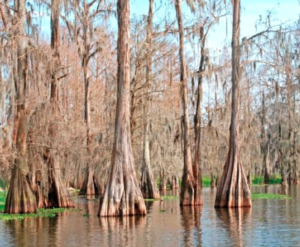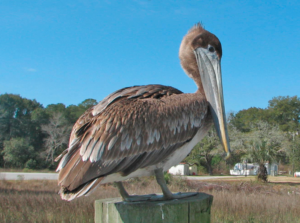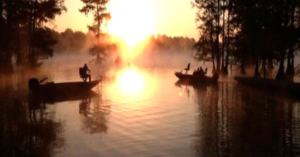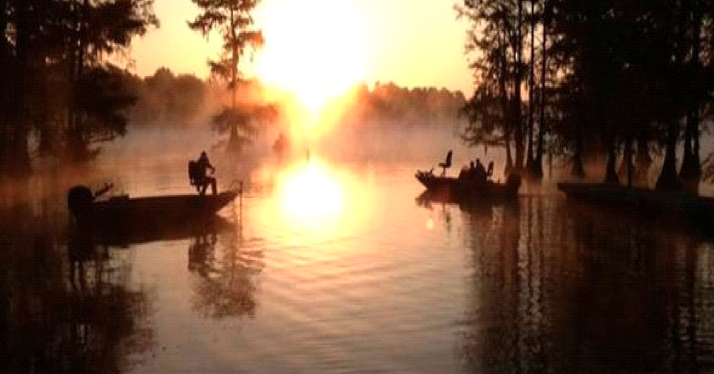Bald Cypress

Louisiana’s swampy areas are the right environment for moss-draped Bald Cypress trees to grow. The Cypress is prized for being a good building material. Its wood is durable and doesn’t rot as quickly as other woods. Short cone-shaped extensions grow from the Cypress’ roots, which are usually underwater in the swampy areas. These are called knees. Researchers believe Cypress knees supply air to parts of the tree that are underwater.
LAGNIAPPE: Louisiana designated the bald cypress official state tree in 1963. (This word, pronounced “lan-yap,” means a little something extra. Example: If you buy some boiled crawfish, the business may throw in some corn and potatoes – a little lagniappe.)
Bayou Lafourche
Louisiana has one of the longest Main Streets in the world. Actually, the locals claim it IS the longest, stretching 65 miles. But, in true Louisiana style … it’s not an actual street, it’s a bayou.

Bayou Lafourche connects the communities of Thibodaux, Raceland, Mathews, Lockport, Larose, Cut Off, Galliano, Golden Meadow, Leeville and Port Fourchon that comprise Lafourche Parish. Bayou Lafourche flows into the Gulf of Mexico, providing Lafourche Parish with one of the largest sea ports on the Gulf Coast, Port Fourchon. Major industries include oil and gas fabrication and service firms, sugar cane, commercial fishing and Nicholls State University.
Shrimp boats dock along the 65-mile-long bayou, called “The Longest Main Street in the World” and small towns offer restaurants serving fresh seafood, produce stands and dance halls where Cajuns welcome visitors to join in a fais-do-do. Roadside shrines attest to the region’s Catholic heritage and in Chauvin a collection of fantastic concrete sculptures created by a loner who packed up and left his creations in 2000 rises beside the bayou.
Stop by the Bayou Lafourche Folklife and Heritage Museum (bayouuseum.org) in Lockport for an introduction to life in the region.
(SOURCES: Dig In Lafourche & Houma Today)
Brown Pelican

Louisiana’s first territorial governor, William C.C. Claiborne had great admiration for the awkward bird that inhabited the Gulf Coast region. The pelican, rather than let its young starve, would tear at its own flesh to feed them. The Governor’s great respect for the Pelican led him to first use the Pelican symbol on official documents in the early 1800s. The brown pelican was officially designated the state bird of Louisiana in 1966.
Chicot State Park
Want to experience some real Louisiana life? Try a night or two at Chicot State Park near Ville Plate, La. Situated in Evangeline Parish in the northern corner of the “Cajun Triangle,” Chicot became a state park in 1939 making it one of the state’s oldest parks. Louisiana claims between 19 and 22 state parks (depending on whom you ask) governed by the Office of State Parks, a division of the Louisiana Department of Culture, Recreation and Tourism. The selection of Louisiana state parks requires that they must be natural areas of unique or exceptional scenic value. Chicot fills the bill with 6,400 acres of land surrounding a 2,000 acre lake – Chicot Lake – stocked full of bass, crappie (sac-au-lait), bluegill, and red-ear sunfish. 
The Louisiana State Arboretum, established in 1961, makes up 600 acres of the park and is the oldest state-supported arboretum in the United States. As a mature Beech-Magnolia forest, the arboretum contains centuries-old giant beech, magnolia, oak, and ash trees, as well as ferns, hickories, maples, sycamores, and crane fly orchids. Wildlife includes white-tail deer, fox, opossum, raccoon, skunk, squirrel, wild turkey, and rumor has it, bobcats.
The park, known for beautiful sunrises, boasts a plethora of Louisiana sportsman activities including fishing, hiking or biking on any of the 22 miles of trails, canoeing, camping and fishing.
LAGNIAPPE: Arkansas has a Lake Chicot State Park. It’s located near Arkansas’s southeastern corner, just north of Monroe.
Crawfish

Crawfish! Mudbugs, crawfish, crayfish, crawdads — no matter how you spell it, these crustacean critters are delicious! Resembling tiny lobsters, they can be found in freshwater streams and are a Southern favorite.
The Native Americans were first credited with trapping and eating crawfish. Crawfish showed up on the first menu in 1920 and was seen as a good source of protein. It attracted the eye of the poor Cajuns but still took some convincing before the locals would eat it. Crawfish etouffe (pronounced e-too-fey) debuted in the 1950’s and is now a quintessential crawfish dish.
Louisiana crawfish is a multimillion dollar industry and LA is the largest producer of crawfish in the world. As of 2005, Louisiana supplies 95% of the crawfish harvested in the United States. In the spring and early summer months, we devour these little creatures with abandon, aware that our time with our little friends is limited to a few short months.
According to Mark Frugé, co-owner of Frugé Aquafarms, “When water temperatures escalate, the crawfish will burrow underground. I don’t know the exact trigger temperature when that happens, but when it gets into the 90’s on a regular basis, the end of the season is nearing.”
And if you think crawfish is just for us Louisianans, The Breaux Bridge Crawfish Festival has been named one of the country’s top 10 food events by USA Today. Crawfish can also be served in soups, étouffées, poboys, and pastas. But no matter how you serve it, it’s sure to be tasty. Here is a great explanation of the history of the crawfish by one of our partner organizations, the LSU AgCenter – “Crawfish have been consumed for centuries by Native Americans and in many parts of Europe, but commercial sale of crawfish in Louisiana only began in the late 1800s…”
LAGNIAPPE:
Concerning crawfish…If you hear someone refer to “crawfish” as “crayfish” or “crawdads” then you know that they are not from Louisiana! Or you might hear someone shout, “Dem crawfish ain’t lookin’ so good dis season, no.” Also, you save newspapers, not for recycling, but for tablecloths at crawfish boils. And you need to know what your host means at a crawfish boil when he says, “Don’t eat the dead ones!”
Louisiana State Cotton Museum

Located in Lake Providence (at the northeastern border of the state), the Louisiana State Cotton Museum provides a great introduction to one of Louisiana’s major agricultural crops. Cotton, the crop for which the Delta area is best known, has been grown in Louisiana for hundreds of years. In the early 1700s, Louisiana cotton was mostly used for home spinning and weaving. But the invention of the cotton gin later that century quickly turned cotton into a cash crop for the state.
The Louisiana State Cotton Museum pays tribute to the history of cotton in Louisiana. The museum has exhibits displaying the history of cotton farming. It features the first electric cotton gin in Louisiana, as well as musical instruments of the Delta Blues. The museum’s main gallery features life-sized dioramas and farming equipment, all located inside a replica gin house, which is where cotton fiber was separated from the seed, or “ginned.” Also on the grounds of the museum is an array of old plantation buildings, such as a sharecropper’s cabin and a small chapel.
Today, cotton is still the most important crop grown in northeast Louisiana. In celebration of the crop, the Louisiana Cotton Festival is held every year in Ville Platte.
(SOURCE: LSU Ag Center)
Magnolia
A true symbol of the South, the beautiful Southern Magnolia is the Louisiana state flower. Named Louisiana’s flower in 1900, we beat out Mississippi, who in 1952, also named the magnolia as their state flower. Dating back almost 130 million years, the magnolia is believed to be among the earliest known flowering plants. Growing prolifically from Shreveport to New Orleans, the majestic blossom has a surprisingly checkered past though, wrought with floral controversy (who knew). In 1950, a 185 member strong group, called the Society for Louisiana Irises, proposed legislation to replace the magnolia blossom with the Louisiana iris as the state flower. Sometimes growing heated, the debate between iris lovers and magnolia supporters tossed allegations that irises are swamp plants and that the magnolia is not unique to Louisiana. The iris lovers did not prevail though and the beautiful magnolia blossom has remained Louisiana’s state flower for over 100 years. It should be noted that the Louisiana iris was adopted as the state’s wildflower in 1990.
LAGNIAPPE: President Andrew Jackson highlighted the magnolia tree during his tenure in office when he planted a magnolia tree on the grounds of the White House in memory of his wife, Rachel.
Wetlands

Louisiana’s 3 million acres of wetlands are lost at the rate about 75 square kilometers annually, but reducing these losses is proving to be difficult and costly. Approximately half the nation’s original wetland habitats have been lost over the past 200 years. In part, this has been a result of natural evolutionary processes, but human activities, such as dredging wetlands for canals or draining and filling for agriculture, grazing, or development, share a large part of the responsibility for marsh habitat alteration and destruction.
Louisiana’s wetlands today represent about 40 percent of the wetlands of the continental United States, but about 80 percent of the losses. The State’s wetlands extend as much as 130 kilometers inland and along the coast for about 300 kilometers. Not all the wetlands are receding; in fact some wetlands are stable, and others are growing. But, at the present net rate of wetlands loss, Louisiana will have lost this crucial habitat in about 200 years.
Over the past 150 years, the Isles Dernieres (seen below, and often referred to as the “Last Island”) have undergone very rapid erosion and land loss due primarily to natural processes of relative sea-level rise, storms, and sand loss by coastal currents. Last Island was a barrier island and a pleasure resort SW of New Orleans. A hurricane destroyed the island in 1856 and, today, only small pieces of several smaller islands remain. As a result of the hurricane and subsequent storms, Isle Dernières was fragmented into five smaller islands: East, Trinity, Whiskey, Raccoon, and Wine (a.k.a. Vine Island).
